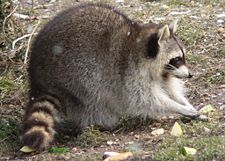Difference between revisions of "Procyonidae" - New World Encyclopedia
Rick Swarts (talk | contribs) (added article from Wikipedia and credit/category tags) |
Rick Swarts (talk | contribs) |
||
| Line 90: | Line 90: | ||
{{reflist}} | {{reflist}} | ||
| − | + | * Myers, P. 2000. [http://animaldiversity.ummz.umich.edu/site/accounts/information/Procyonidae.html Procyonidae]. ''Animal Diversity Web''. Retrieved November 22, 2008. | |
| − | + | ||
| + | * Larivière, S. 2004. In B. Grzimek, D. G. Kleiman, V. Geist, and M. C. McDade. 2004. ''Grzimek's Animal Life Encyclopedia.'' Detroit: Thomson-Gale. ISBN 0307394913. | ||
{{Carnivora}} | {{Carnivora}} | ||
Revision as of 16:41, 22 November 2008
| Procyonids
| ||||||||||||||
|---|---|---|---|---|---|---|---|---|---|---|---|---|---|---|
 | ||||||||||||||
| Scientific classification | ||||||||||||||
| ||||||||||||||
|
†Plesictis |
Procyonidae is a New World family of the order Carnivora. It includes the raccoons, coatis, kinkajous, olingos, ringtails and cacomistles. Procyonids inhabit a wide range of environments, and are generally omnivorous.
Characteristics
Procyonids are smallish animals, with generally slender bodies and long tails. (The common raccoon tends to be bulky.) Except for the kinkajou, all procyonids have banded tails, and distinct facial markings. These are especially visible in the raccoons. Like bears, procyonids are plantigrade, walking on the soles of their feet. Most species have non-retractile claws.
Because of their omnivorous diet, procyonids have lost some of the adaptations for flesh-eating found in their carnivorous relatives. While they do have carnassial teeth, these are poorly developed in most species, especially the raccoons. Apart from the kinkajou, procyonids have the dental formula:
| 3.1.4.2 |
| 3.1.4.2 |
While coatis are diurnal, all other procyonids are nocturnal. They are mostly solitary animals, and the mother raises litters of up to four young on her own.[1]
Evolution
Fossils belonging to the genus Bassariscus, which includes the modern ringtail and cacomistle, have been identified from the Miocene epoch, around twenty million years ago. It has been suggested that early procyonids were an offshoot of the canids that adapted to a more omnivorous diet.[1]
Classification
Recent genetic studies have shown that the kinkajous were an early offshoot of the ancestral procyonid line and are not closely related to any of the other extant genera; coatis and olingos are closest relatives, while the closest relatives of the raccoons are the ringtails and cacomistles.[2] These data are not yet reflected in the classification scheme, which groups kinkajous and olingos together on the basis of similarities in morphology which are now known to be an example of parallel evolution.
There is considerable uncertainty over the correct classification of several members. The Red Panda was previously classified in this family, but some experts, including Don E. Wilson and DeeAnn M. Reeder, classify it as a member of the bear family (Ursidae) or in its own family the Ailuridae. The status of the various olingos is disputed: they may all be better regarded as subspecies of Bassaricyon gabbii.
Because of their general build, the Procyonidae are often viewed as smaller cousins of the bear family. This is apparent in their German names: a raccoon is called a Waschbär (washing bear, as he "washes" his food before eating), a coati is a Nasenbär (nose-bear) while a Kinkajou is a Honigbär (honey-bear). Dutch follows suit, calling the animals wasbeer, neusbeer and rolstaartbeer respectively.
- FAMILY PROCYONIDAE
- Subfamily Procyoninae (9 species in 4 genera)
- Raccoons, Procyon
- Crab-eating Raccoon, Procyon cancrivorus
- Tres Marias Raccoon, Procyon insularis
- Common Raccoon, Procyon lotor
- Coatis, Nasua
- Coatimundi or Ringtailed Coati, Nasua nasua
- White-nosed Coati, Nasua narica
- Cozumel Island Coati, Nasua nelsoni
- Mountain Coatis, Nasuella
- Mountain Coati, Nasuella olivacea
- Ringtails and Cacomistles, Bassariscus
- Ringtail, Bassariscus astutus
- Cacomistle, Bassariscus sumichrasti
- Raccoons, Procyon
- Subfamily Potosinae (6 species in 2 genera)
- Kinkajous, Potos
- Kinkajou, Potos flavus
- Olingos, Bassaricyon
- Olingo, Bushy-tailed Olingo or Gabbi's Olingo, Bassaricyon gabbii
- Allen's Olingo, Bassaricyon alleni
- Beddard's Olingo, Bassaricyon beddardi
- Harris's Olingo, Bassaricyon lasius
- Chiriqui Olingo, Bassaricyon pauli
- Kinkajous, Potos
- Subfamily Procyoninae (9 species in 4 genera)
ReferencesISBN links support NWE through referral fees
- ↑ 1.0 1.1 Russell, James (1984). in Macdonald, D.: The Encyclopedia of Mammals. New York: Facts on File, 98-99. ISBN 0-87196-871-1.
- ↑ K.-P. Koepfli, M. E. Gompper, E. Eizirik, C.-C. Ho, L. Linden, J. E. Maldonado, R. K. Wayne (2007). Phylogeny of the Procyonidae (Mammalia: Carvnivora): Molecules, morphology and the Great American Interchange. Molecular Phylogenetics and Evolution 43: 1076–1095.
- Myers, P. 2000. Procyonidae. Animal Diversity Web. Retrieved November 22, 2008.
- Larivière, S. 2004. In B. Grzimek, D. G. Kleiman, V. Geist, and M. C. McDade. 2004. Grzimek's Animal Life Encyclopedia. Detroit: Thomson-Gale. ISBN 0307394913.
| ||||||||
Template:Procyonidae nav
Credits
New World Encyclopedia writers and editors rewrote and completed the Wikipedia article in accordance with New World Encyclopedia standards. This article abides by terms of the Creative Commons CC-by-sa 3.0 License (CC-by-sa), which may be used and disseminated with proper attribution. Credit is due under the terms of this license that can reference both the New World Encyclopedia contributors and the selfless volunteer contributors of the Wikimedia Foundation. To cite this article click here for a list of acceptable citing formats.The history of earlier contributions by wikipedians is accessible to researchers here:
The history of this article since it was imported to New World Encyclopedia:
Note: Some restrictions may apply to use of individual images which are separately licensed.